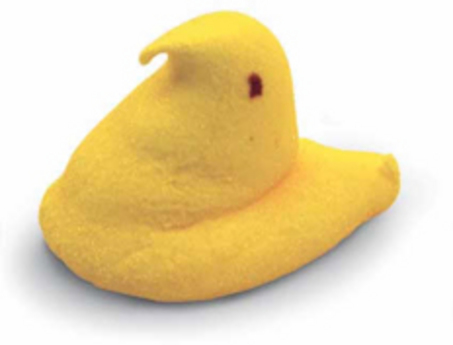Easter is coming up and that means the return of those yellow, blue, and pink marshmallow treats called Peeps.
The popular, chick-shaped candy has been around for more than 60 years. 
Thanks to the USA TODAY Network for sharing some surprising facts about these iconic marshmallow confections:
Peeps were once made by hand and took nearly 30 hours to create.
Peeps are owned and made by Just Born Inc., a candy company located in Bethlehem, Pa.
The company is named after Sam Born, a Russian-born founder and confectioner, who started the brand in 1917 after immigrating to the United States. His candy company grew and eventually acquired Rodda Candy Company in 1953.
"They were primarily interested in that company for the jelly bean technology," Matt Pye, the vice president of corporate affairs for Just Born, told USA TODAY Network.
"But while the family was touring the Rodda Candy Company, in the back part of the factory were these women with pastry tubes squirting these marshmallow chicks by hand," Pye said. It took the women 27 hours from start to finish to make the Peeps mostly because it took the marshmallow a long time to cool before it could be packaged for consumers.
The Born family figured out a way to automate the process and quickly cool the Peeps. By 1954, the company had shortened the manufacturing time to only about six minutes.
Today, Just Born makes about 5.5 million each day in a variety of shapes and colors
Original Peeps had wings.
The original Peep had two small wings coming off the back of each bird.
Just Born initially included those wings in the process as well, but it made the automation process more complicated, according to Pye.
In 1955, the company decided to skip the wings to streamline the process, he said.
Peeps stores exist.
You can find Peeps on grocery store shelves and in candy stores, but there are also several brick-and-mortar shops specializing in Peeps.
The first Peeps-theme store opened in 2009 in Oxon Hill, Md., right outside Washington, D.C.
Since then the company has opened two other locations: one in Bethlehem, Pa., and another in the Mall of America in Bloomington, Minn. The stores carry Peeps of all colors, flavors and shapes in addition to Peeps-brand merchandise such as T-shirts and plush toys. They also sell other Just Born candies such as Mike & Ike's and Hot Tamales.
There are bunny Peeps. Yes, bunnies.
Even from the very beginning, the company made bunnies in addition to chicks and very quickly introduced other shapes by the 1960s, Pye said.
Today there are bunny and chick Peeps available in a number of colors including yellow, blue, lavender, orange, pink and white. That being said, chicks still rule supreme. Four out 5 Peeps purchased are shaped like chicks, according to a statement from Just Born.
An estimated one-third of all Peeps purchased are not eaten but instead used for decorations or for craft projects like dioramas, according to Pye.
"We think there are more people who love the brand whether they eat it or not," he said.